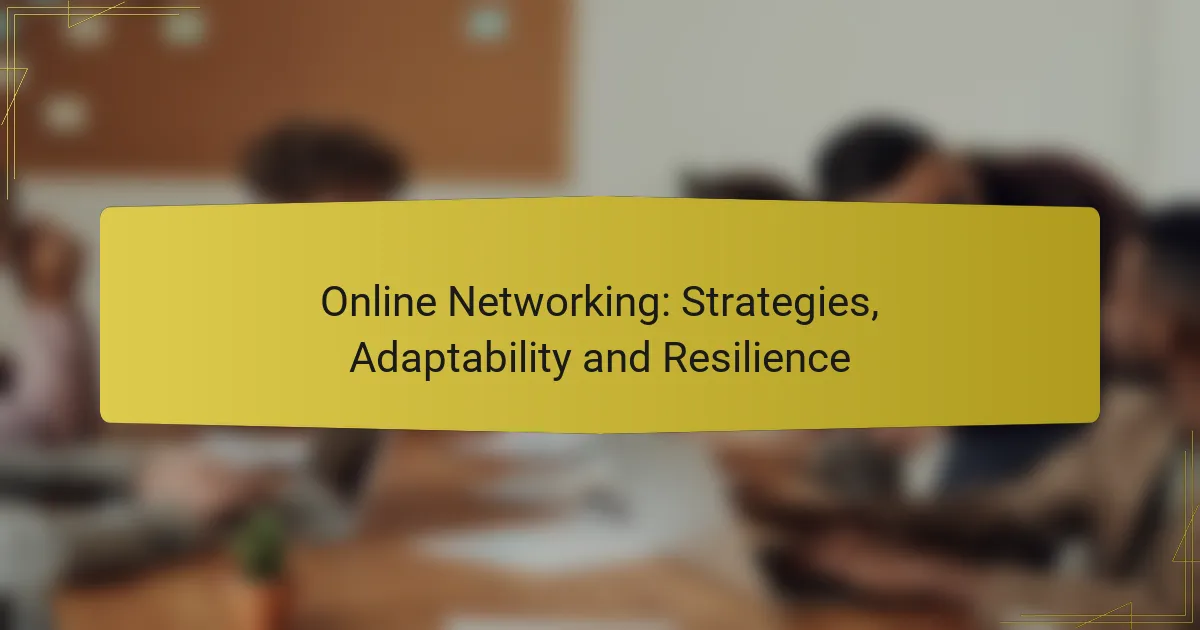In today’s digital landscape, effective online networking is essential for building professional relationships and creating opportunities. By leveraging social media, attending virtual events, and engaging in online communities, individuals can enhance their visibility and connectivity. Adapting one’s networking approach and maintaining resilience are crucial for navigating the evolving challenges of digital interactions.

What Are Effective Online Networking Strategies?
Effective online networking strategies involve leveraging digital platforms to build professional relationships, share knowledge, and create opportunities. Key approaches include using social media, attending virtual events, and participating in online communities to enhance visibility and connectivity.
Leveraging LinkedIn for Professional Growth
LinkedIn is a powerful tool for professional networking, allowing users to connect with industry peers and showcase their expertise. Regularly updating your profile, engaging with content, and joining relevant groups can significantly enhance your visibility.
To maximize LinkedIn’s potential, consider sharing insightful articles or writing posts that reflect your professional experiences. Aim to connect with individuals in your field and personalize your connection requests to foster meaningful relationships.
Utilizing Virtual Networking Events
Virtual networking events provide opportunities to meet professionals from various industries without geographical constraints. These events often include panel discussions, breakout sessions, and Q&A segments that facilitate interaction.
When attending, prepare by researching speakers and participants, and come equipped with thoughtful questions. Follow up with new contacts post-event to solidify connections and explore potential collaborations.
Building Online Communities
Creating or joining online communities centered around your interests or profession can foster deep connections. Platforms like Facebook Groups or specialized forums allow for ongoing discussions and support among members.
To build a successful community, actively participate by sharing resources, answering questions, and encouraging discussions. Establish clear guidelines to maintain a positive environment and ensure that all members feel valued.
Engaging on Social Media Platforms
Social media platforms such as Twitter and Instagram can be effective for networking when used strategically. Engaging with industry leaders and participating in relevant conversations can increase your visibility and credibility.
Utilize hashtags related to your field to discover and join discussions. Regularly share content that reflects your expertise and interests, and don’t hesitate to comment on others’ posts to build rapport and connections.
Participating in Webinars and Workshops
Webinars and workshops offer valuable learning experiences while providing networking opportunities with participants and speakers. These events often allow for interactive Q&A sessions, fostering direct engagement.
To make the most of these opportunities, actively participate by asking questions and contributing to discussions. After the event, connect with speakers and attendees on professional networks to continue the conversation and explore collaboration possibilities.

How to Adapt Your Networking Approach?
Adapting your networking approach involves evaluating your current skills, identifying your target audience, and adjusting your communication style to fit various platforms. This flexibility is crucial for building meaningful connections in an increasingly digital world.
Assessing Your Current Networking Skills
Begin by taking stock of your existing networking abilities. Consider your comfort level with both in-person and online interactions, as well as your proficiency in using networking tools like LinkedIn or professional forums. Self-assessment can help pinpoint areas for improvement.
Utilize feedback from peers or mentors to gauge your effectiveness in networking situations. This can provide insights into your strengths and weaknesses, allowing you to focus on specific skills that need enhancement.
Identifying Target Audiences
Understanding who you want to connect with is essential for effective networking. Define your target audience based on your professional goals, whether they are industry peers, potential clients, or mentors. Tailoring your approach to these groups can lead to more fruitful interactions.
Research the platforms where your target audience is most active. For instance, tech professionals may prefer forums like GitHub, while creatives might engage more on platforms like Instagram or Behance. This knowledge helps you focus your networking efforts where they will be most effective.
Adjusting Communication Styles
Different audiences require different communication styles. For formal settings, such as industry conferences, maintain a professional tone and clear messaging. In contrast, casual networking events may allow for a more relaxed and personable approach.
Be mindful of cultural differences in communication, especially if networking internationally. Understanding local customs and etiquette can enhance your interactions and make a positive impression.
Embracing New Technologies
Staying current with networking technologies is vital for adapting your approach. Familiarize yourself with tools like video conferencing software, social media platforms, and professional networking sites. These technologies can broaden your reach and facilitate connections that might not be possible otherwise.
Consider participating in virtual networking events or webinars to expand your network. These platforms often provide opportunities to meet industry leaders and peers, allowing for meaningful exchanges without geographical constraints.

What Are the Key Resilience Factors in Networking?
Key resilience factors in networking include the ability to maintain consistent engagement, build a diverse network, and learn from failures. These elements help individuals adapt to changing circumstances and strengthen their professional relationships over time.
Maintaining Consistent Engagement
Consistent engagement is crucial for nurturing relationships in networking. Regularly reaching out to contacts through emails, social media, or virtual meetings keeps connections alive and demonstrates your interest in their work.
Consider setting a schedule for outreach, such as monthly check-ins or quarterly updates. This can help you stay organized and ensure that you are actively participating in your network.
Building a Diverse Network
A diverse network encompasses individuals from various industries, backgrounds, and experiences. This diversity can provide unique perspectives and opportunities that a homogenous network may lack.
To build a diverse network, attend events outside your usual industry, join different professional groups, and engage with people from various cultural backgrounds. Aim for a mix of skills and experiences to enrich your networking outcomes.
Learning from Networking Failures
Failures in networking can be valuable learning experiences. Analyzing what went wrong—whether it was a missed opportunity or a poorly received pitch—can provide insights for future interactions.
Keep a record of your networking attempts and reflect on them regularly. Identify patterns in your failures and adjust your strategies accordingly. This proactive approach can help you avoid similar pitfalls in the future.

What Criteria Should You Consider When Choosing Networking Platforms?
When selecting networking platforms, consider user demographics, available features, and integration capabilities. These factors will help you identify the most suitable platform for your professional goals and audience engagement.
Platform User Demographics
Understanding the user demographics of a networking platform is crucial for effective engagement. Look for platforms that cater to your target audience, whether they are industry professionals, entrepreneurs, or job seekers. For example, LinkedIn is popular among professionals, while platforms like Meetup attract community-focused individuals.
Evaluate the age, location, and interests of the user base to ensure alignment with your networking objectives. A platform with a diverse demographic may offer broader opportunities, while a niche platform might provide more targeted connections.
Features and Tools Offered
Different networking platforms offer various features that can enhance your networking experience. Key tools to consider include messaging options, event hosting capabilities, and content sharing functionalities. For instance, platforms like Slack provide real-time communication, while others like Eventbrite focus on organizing events.
Assess whether the platform supports multimedia sharing, group discussions, and analytics to track engagement. Prioritize platforms that offer features that align with your networking strategy, such as video calls for remote meetings or forums for discussions.
Integration with Other Tools
Integration with other tools is essential for a seamless networking experience. Check if the platform can connect with your existing tools, such as CRM systems, email marketing services, or project management software. For example, platforms like HubSpot integrate with various applications to streamline your networking efforts.
Consider how these integrations can enhance your workflow and improve communication. A platform that easily connects with tools you already use can save time and increase efficiency, allowing you to focus more on building relationships.

How to Measure the Success of Your Online Networking?
To measure the success of your online networking, focus on key metrics such as the number of meaningful connections made, engagement levels, and opportunities generated. Tracking these factors will help you assess the effectiveness of your networking strategies.
Key Metrics to Track
When evaluating online networking success, consider metrics like connection growth, engagement rates, and conversion rates. Connection growth refers to the increase in your professional contacts over time, while engagement rates can be measured through interactions such as comments, shares, and direct messages. Conversion rates indicate how many connections lead to tangible opportunities, such as job offers or collaborations.
Utilizing tools like LinkedIn Analytics or social media insights can help you gather data on these metrics. Regularly reviewing these numbers allows you to adjust your networking strategies as needed.
Qualitative Assessments
In addition to quantitative metrics, qualitative assessments are essential for understanding the impact of your networking efforts. Reflect on the quality of your connections and the depth of your interactions. Are you forming genuine relationships or merely expanding your contact list?
Gather feedback from peers or mentors about your networking approach. Their insights can provide valuable perspectives on your effectiveness and areas for improvement.
Setting Goals and Benchmarks
Establish clear goals and benchmarks to guide your networking efforts. For instance, aim to connect with a specific number of industry professionals each month or participate in a set number of online events. These targets will help you stay focused and motivated.
Regularly reassess your goals based on your progress and changing circumstances. Adjusting your benchmarks ensures they remain relevant and achievable, helping you maintain momentum in your networking journey.
